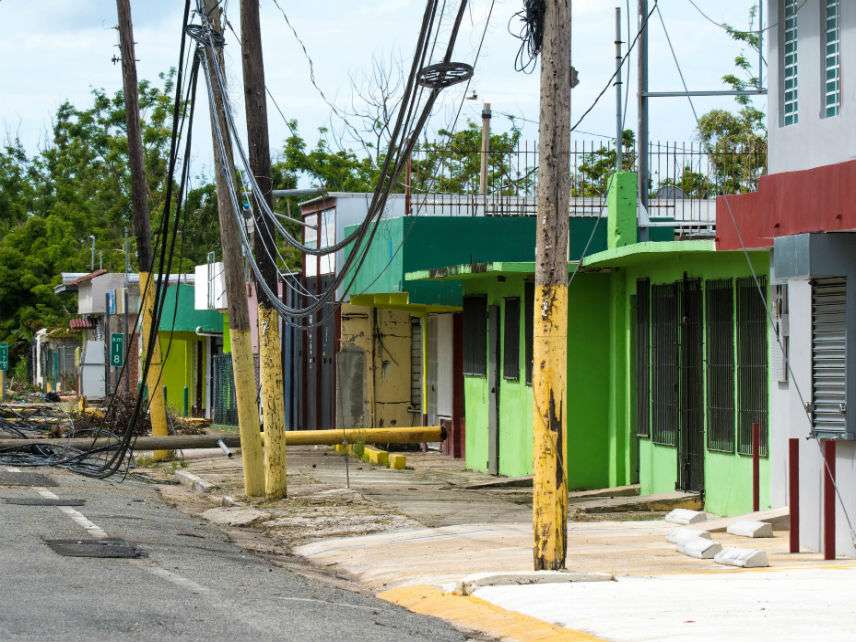Study: Puerto Rico's Post-Hurricane Maria Death Rate At Least 70 Times Higher Than Official Figures
Disasters result from policies adopted and choices made before and after a natural hazard strikes.

According to the National Oceanic and Atmospheric Administration's official accounting, 65 people in Puerto Rico died as a result of Hurricane Maria. The agency does note that "hundreds of additional indirect deaths in Puerto Rico may eventually be attributed to Maria's aftermath pending the results of an official government review."
"Hundreds" may be an understatement. A new study in the New England Journal of Medicine estimates the number of such indirect deaths at 4,645 people—more than 70 times higher than the official figure. This is a 62 percent increase in the mortality rate compared with the same period in 2016. It should be no surprise that the death rate for our fellow citizens in Puerto Rico rose after Hurricane Maria blocked most roads and knocked out power, cellular phone service, and potable water supplies for weeks at a time.
The Harvard-based researchers made this calculation based on a randomized survey of 3,299 households asking respondents if anyone they knew had died between September 20 and December 31, 2017. They also asked how they died and whether their deaths could be attributed to the aftermath of Hurricane Maria. Using a survey similar to the Centers for Disease Control and Prevention (CDC) death scene investigation form for post-hurricane deaths, they identified 38 deaths among those households, of which 12 died of causes unrelated to the hurricane. The householders attributed the deaths of 12 people to the interruption of necessary medical services and 3 from medical complications stemming from an injury, trauma, or illness directly due to the hurricane. From there they extrapolated the mortality rate to Puerto Rico's 1,135,000 households.
The full death count may be even worse: The study adds that the estimate "is likely to be an underestimate because of survivor bias."
Counting and attributing deaths that result indirectly from natural disasters is a fraught enterprise. For example, NOAA's initial 2005 report on Hurricane Katrina noted that "the total number of fatalities known, as of this writing, to be either directly or indirectly related to Katrina is 1833." The agency has since lowered its estimate of deaths attributed to Katrina to 1,200 people.
A 2007 study using data from death notices published in the Times-Picayune before and after Hurricane Katrina hit Louisiana in August 2005, however, calculated that the mortality rate for the region rose by 47 percent between January and June of 2006. The researchers found that the monthly rate of death notices in the Times-Picayune averaged 924 per month in 2002–2004, but rose to 1,317 per month between in the first half of 2006. Roughly calculated, that means that there were 2,358 excess deaths in the period after Katrina.
While Puerto Rican public health authorities have acknowledged that 472 more people died in September after Hurricane Maria compared with the same month in the previous year, they did not officially attribute most of those deaths to the effects of the storm. Given the controversy over post-Maria mortality statistics, the Puerto Rican government in February asked researchers at George Washington University to conduct a study to estimate the excess mortality tied to the hurricane.
These researchers are tasked with reviewing and analyzing existing records and death certificates and then estimating the excess mortality from the time the storm hit on September 20 through the end of February 2018. They will also evaluate the current CDC guidelines for identifying mortality during such a disaster and how well Puerto Rican public health officials followed those procedures. Their preliminary report is due in the next month or so.
In a sense, there is no such thing as a natural disaster. There are natural hazards, such as hurricanes and earthquakes, but disasters result from policies adopted and other choices made prior to and after a hazard strikes. In the case of Hurricane Katrina, badly engineered and maintained levees led to the inundation of New Orleans and the deaths of hundreds of people. Hurricane Maria destroyed a decayed electric power grid and badly neglected roads, bridges, and water supply systems made fragile by years of massive fiscal irresponsibility.
Hopefully, having a clearer idea of how many people died at Maria's hands will help the public determine how to prevent the next storm from becoming a humanitarian disaster.



Show Comments (62)